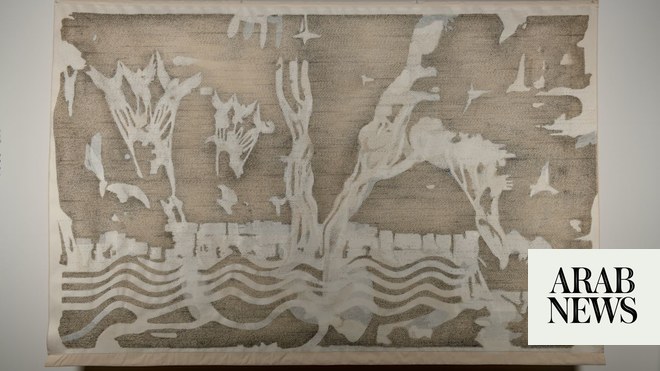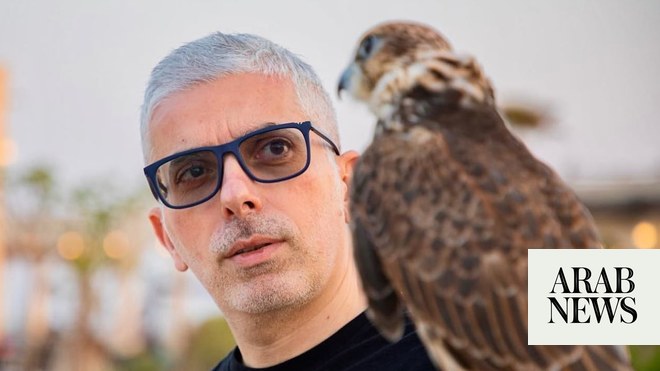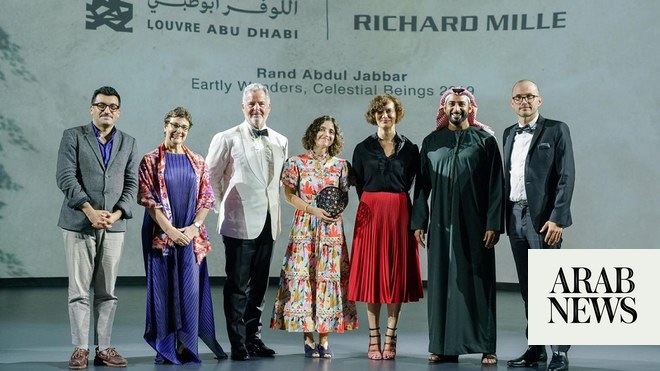
The artist’s ‘On’ represents an ancient slave rebellion in his homeland
DUBAI: The Helsinki-based Iraqi artist Adel Abidin’s work “On” (‘Aan’ in Arabic) was unveiled at the King Abdulaziz Center for World Culture (Ithra) this month. His proposal for the work won Abidin the Ithra Art Prize earlier this year.
For the latest updates, follow us on Instagram @arabnews.lifestyle
The large-scale mural, imbued with abstract inked figures on Japanese rice paper, takes center stage inside Ithra’s Great Hall. It explores the intricate relationship between history, memory and identity while also touching on the intangible and crucial aspects of oral storytelling, particularly, as Abidin emphasizes, in the context of Arab history, much of which is shrouded in ambiguity and differing interpretations.
Abidin’s design was selected from more than 10,000 submissions by a jury comprising gallerists, academics, curators and artists. His prize was $100,000, in addition to the full funding required to bring his project to fruition. It is now part of Ithra’s permanent art collection.
Abidin’s work confronts the subjectivity of historical discourses by reexamining oral accounts of the Zanj rebellion against the Abbassid Caliphate, which began in 869 CE in southern Iraq. He has, he says, tried to incorporate greater nuance with the inclusion of previously overlooked perspectives. The repeated stamping of the word “Aan” in Arabic script reflects the word-of-mouth stories that have been lost from historical records, while overlapping visual representations of varied, even contradictory, versions of the tale of the rebellion, result in an abstract work that allows the viewer to interpret it for themselves.
“The piece examines the intangibility of history through the tradition of oral storytelling and the narration of history. Recently, I have been very interested in studying history, especially its intangible and vulnerable aspects,” Abidin tells Arab News. “But I couldn’t just study history in general; I needed a case to focus on. And I found this very interesting revolt that took place in southern Iraq, with the aim of emancipating slaves. I found this matter to be worth digging deeper into.”
In 869, slaves (referred to as “Zanj” in numerous sources) — mostly of African origin and enslaved in Basra — rose up against their masters and against the Abbasid caliphate in protest against the harsh conditions in which they lived.
“When I won the award and began really researching this story, I realized how everyone told a different story about his or her origins,” says Abidin. “It’s almost as if no one really knew where she or he was from. It is fascinating and it makes for great material.”
Abidin found that the oral reports of the rebellion had been modified. Such ambiguity in the storytelling served as his impetus for naming his artwork “On.”
“This process creates a vivid representation of the 14-year rebellion against the Abbasid Caliphate and offers a fresh perspective on this significant event in Arab history,” he stated. “The resulting wall installation highlights the ultimate fragility of history and the organic, but unreliable, nature of memory.”
Abidin, who moved to Finland from Iraq in 2001, has, for much of his career, created works that combine politics, art, memory and identity. He has used various mediums to present his bold and thought-provoking visions, including video, installation, sculpture and painting.
His Ithra Art Prize-winning work is more delicate in nature — and less ‘edgy’ than the artist’s previous works. But, as Abidin points out, it is equally audacious in its own way.
“When I began the work, I was out of my comfort zone; I had never worked this way before,” he explains. “I have never used this technique before; I’ve never worked with ink or rice paper in this manner in my entire life."
Abidin hired a specialist in the use of Japanese rice paper and traditional gluing techniques to teach him. “I learned and now I want to continue,” he says.
“I wanted to give the piece every sound and sight — the entire story — but I didn’t want to be a historian,” he continues. “The best way to do that was to stamp it with the word ‘on.’ By stamping that word, I am interpreting what happened with my own emotions.”
Viewing the work, one can see that Abidin pressed down harder with the stamp in some places, so there are a variety of shades within the iterations of “on.”
“Technically, I was very keen to create a work that gives the feeling of a tapestry of history,” he says.
He has succeeded. The ethereal yet grand nature of “On” gives it a sense of historical importance — although it is still very much of the present too, with its abstract lines and forms shifting in and out of each other like they are dancing, or fighting, or rebelling, in an echo of the actual uprising that happened so long ago and is now brought back to life through Abidin’s work.












